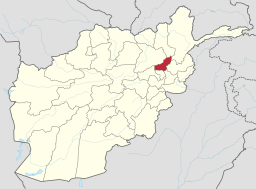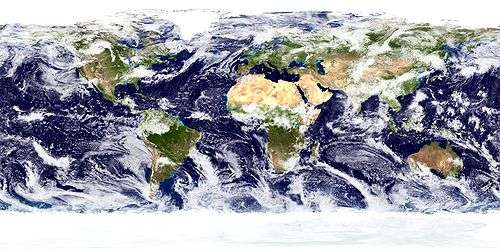Panjshir Valley
The Panjshir Valley (also spelled Panjsheer or Panjsher; Persian: درهٔ پنجشير – Dare-ye Panjšēr; literally Valley of the Five Lions) is a valley in north-central Afghanistan, 150 kilometres (93 mi) north of Kabul, near the Hindu Kush mountain range.[1] It is divided by the Panjshir River. The valley is home to more than 100,000 people, including Afghanistan's largest concentration of ethnic Tajiks.[2] In April 2004, it became the heart of the new Panjshir Province, having previously been part of Parwan Province.[3]
| Panjshir Valley | |
|---|---|
 A view of Afghanistan's Panjshir Valley | |
 Map of Afghanistan with Panjshir highlighted |
It was the site of the Panjshir offensives fought between the Democratic Republic of Afghanistan and the Soviets against the mujahideen during the Soviet–Afghan War from 1980 to 1985, when local commander Ahmad Shah Massoud successfully defended the valley from being taken. The valley again witnessed renewed fighting during the 1996–2001 civil war between the Taliban and the Northern Alliance under the command of Massoud, where he again defended it from being overrun by the Taliban.[4] As of 2016, the Panjshir Valley is considered one of Afghanistan's safest regions.[5]
Name
The name Panjshir, literally meaning "Five Lions", widely believed that it refers to five Wali (literally, protectors), highly spiritual brothers who were centered in the valley. Local legend has it that the five brothers built a dam for Sultan Mahmud of Ghazni in the early 11th century AD. The foundations serve today for a modern reservoir. However, the name Panjshire was used by Arab conquerers in the 7th century which means the legend of five Wali must have existed before the 11th century.
Economy and natural resources
The Panjshir Valley has the potential to become a major centre of emerald mining. As early as the 1st century AD, Pliny the Elder commented on gemstones from the region.[6] In the Middle Ages, Panjshir was famed for its silver mining and the Saffarids and Samanids minted their coins there.[7] As of 1985, crystals upwards of 190 carats (38 g) had been found there, reported to rival in quality the finest crystals of the Muzo mine in Colombia.[6] American reconstruction efforts in Afghanistan has sparked a development boom in the valley with the construction of new modern roads and a new radio tower that allows valley residents to pick up radio signals from the Afghan capital, Kabul.[8] The valley has the potential of being an energy hub for Afghanistan, through construction of several hydroelectric dams. Rewat locality can be the site of the first dam. The valley can make the capital region power self-reliant. The construction of an asphalted road to the Badakhshan Province can contribute to the prosperity of the valley. Tourism can constitute another major source of income.
The Panjshir has always been an important highway. Nearly 100 km long, it leads to two passes over the Hindu Kush – the Khawak Pass (3,848 m) leading to the northern plains, and the Anjoman Pass (4,430 m) that crosses into Badakhshan – used by the armies of Alexander the Great and Timur.
A 10-turbine wind farm was built in Panjshir Valley in April 2008.[9]
Popular culture
- The Panjshir Valley is the central setting of Ken Follett's 1985 spy novel Lie Down with Lions.
- The valley is featured in Steven Pressfield's 2006 historical novel The Afghan Campaign.
- The Panjshir Valley and a description of the same is mentioned in Eric Newby's famous A Short Walk in the Hindu Kush.
- The valley is discussed in The Lion's Grave by journalist Jon Lee Anderson.
- The valley is the setting of L'étoile du soldat, a 2006 french film directed by Christophe de Ponfilly.
References
- "Afghanistan gets rid of heavy arms in Panjshir". Xinhua. 2005-03-06. Archived from the original on 2006-10-16. Retrieved 2006-11-22.
- "Afghanistan". Library of Congress Country Studies. Library of Congress. 1997. Retrieved 2006-11-19.
- American Forces Press Service (5 July 2006). "New Afghan Road Offers Gateway to Optimism". archive.defense.gov. U.S. Department of Defense. Retrieved 16 August 2017.
- https://www.vanityfair.com/news/2002/02/junger200202
- https://www.thenational.ae/world/foreign-kayakers-surprise-afghans-in-the-panjshir-valley-1.136676
- Bowersox, Gary; Lawrence W. Snee; Eugene E. Foord; Robert R. Seal II (1991). "Emeralds of the Panjshir Valley, Afghanistan". Gems and Gemology. Gemological Society of America. Spring: 26–39.
- "Pandjhir". Encyclopaedia of Islam (CD-ROM v. 1.0 ed.). Leiden, The Netherlands: Koninklijke Brill NV. 1999.
- Anderson, John Ward (2007-09-28). "A Haven of Prosperity in Afghanistan: U.S. Building Effort Blooms in Panjshir". The Washington Post. p. A11. Retrieved 2007-10-09.
- "Power to the People: Getting 'off the grid'". EcoBob. 2008-07-16. Archived from the original on 2009-02-23. Retrieved 2010-01-10. Cite journal requires
|journal=(help)
External links
- Where the Sun Rises: Afghanistan (video Sept. 1, 2017)
- Photographs from the Panjshir Province
